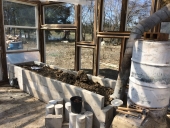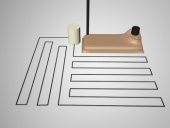




Community Building 2.0: ask me about drL, the rotational-mob-grazing format for human interactions.
 2
2




'Theoretically this level of creeping Orwellian dynamics should ramp up our awareness, but what happens instead is that each alert becomes less and less effective because we're incredibly stupid.' - Jerry Holkins
 1
1




 3
3













Travis Johnson wrote:I love steam, but it is a tricky medium to work with.
It sounded like you wanted to get steam to thermos siphon, and it will not do that. You would have to put it under some sort of pressure. You would still have to put a high point vent in any spot that rises otherwise you will get a dead spot or steam hammer, but that is basic steam stuff. But once pressurized, it does not matter how high something is because its running in its own environment.
The other tricky part is that steam requires (3) systems; supply, return, and then condensate return. Every so many feet, x amount of steam is going to cool and drop out as water, so that water has to be collected, and returned to the boiler to be heated again. Any meaningful lengths of run, turns, etc is going to generate decent amounts of condensate, so that has to be dealt with.
But if you want to see something neat, look up Crowley's 6 stroke engine...that is a gasoline/steam engine hybrid! (Intake, compression, power (fuel oil), exhaust, 2nd intake, 2nd power (steam)...a true 6 stroke engine.
The other thing that might work better is a salt water brine water solution instead of steam???
Community Building 2.0: ask me about drL, the rotational-mob-grazing format for human interactions.









D Nikolls wrote:I think you will have issues getting a lame, inefficient, pressure-worthy, affordable solar heater to add useful amounts of heat to steam.
If you have to be absent or shut the system down for Reasons in winter, you may have issues with freezing after all, unless you have successfully gone to great lengths to design out any possible ways for water to remain after cooldown.
I don't know enough about steam to say for sure that getting the hotter steam to come back down will be hard... but it seems like it might be?
I also think that PV panels are a better value for the vast majority of cases at this point, and likely to keep getting better...
Community Building 2.0: ask me about drL, the rotational-mob-grazing format for human interactions.









Sebastian Köln wrote:I don't think the one-way valves will convince the hot stream to down. You essentially have two vertical pipes with steam of different temperatures in them. The one with a higher temperature will rise and the other fall.




Be the shenanigans
you want to see in the world.










Community Building 2.0: ask me about drL, the rotational-mob-grazing format for human interactions.




 1
1




 1
1




Sebastian Köln wrote:Why not the simple solution: Draining the pipes at night?
EDIT: Saltwater sounds like a nightmare if any metals are involved (corrosion!)









![Filename: thermal-conductivity-saturated-steam-chart-(1).png
Description: thermal conductivity saturated steam [Thumbnail for thermal-conductivity-saturated-steam-chart-(1).png]](/t/131961/a/97768/thermal-conductivity-saturated-steam-chart-(1).png)
Community Building 2.0: ask me about drL, the rotational-mob-grazing format for human interactions.
 2
2




Aim High. Fail Small.
Repeat.









Eliot Mason wrote:So steam is great when you have excess heat at the heat source - think a giant gas burner. In Hot Water solar systems you work very hard to ensure that the system never approaches the boiling point - sure a release valve works, until it doesn't and then you blow out a panel. I also think that the pressures you can get with steam may exceed those of standard plumbing (about 70 psi), which is why the old steam radiators always seemed to be connected with steel pipes with something that looks like a 1/4" wall.
In that same vein ... we had a 2 panel (~100 sq ft) system in Wisconsin. In the summer we could boil the water tank, but in the winter ... if we could just preheat water to 50 F that was a victory. Maybe on the equator you could get steam in the winter? Adding more panels probably wouldn't work as the Delta Ts are too low.
Stay away from salt water. You've got to think about the whole system - even if you get pipes that won't corrode (and I think that's pretty much just PVC! yay, PVC...) then you need a panel and peripherals as well. There's a reason the panels are made with copper - it transfers the heat to the fluid! - so using another material isn't as efficient. Pumps for this application are not expecting salt water - some of the preferred pumps are cast iron and salt water will eat that quickly.
There is a solar water design called "Drain Back" - and it relies on a clever temperature sensor and a valve. Too cold? dump the water. Again, works great until it doesn't and everything on the roof freezes. The advantage of drain back is that it can be an open system - the water just comes from your main feed and gets heated until it wanders down a pipe to your shower. A glycol or closed system requires a fancier heat-exchange tank - but my installers were convinced that glycol was the superior solution - its easy to measure the glycol in the water and calculate the freezing point, it lasts a long time ( I think at least 5 years), and after install it doesn't require anything to work properly to prevent damage. And you don't need much glycol - maybe two gallons?
Of course, I wouldn't install solar water now. PV is so much less expensive now, and paired with a heat-pump water heater you get a solution that: heats your water, produces electricity for the rest of your life, and dumps cold air into your house (in the summer... pipe it outdoors in the winter). Our WI system worked best in spring and fall ... in the winter we had to rely on the in-line gas heater and in the summer we had so much heat that we had to upgrade the controller to bleed off heat at night! The 80 gallon storage tank would approach 200 F, and there's really no way to do enough dishes, laundry and showers to deal with that much heat. PVs don't care about the cold winter and merrily produce power all year.
Community Building 2.0: ask me about drL, the rotational-mob-grazing format for human interactions.












I always recommend against the use of glycol in any heating system though because it makes the system instantly 10% less efficient over straight water.
Aim High. Fail Small.
Repeat.

|
Cob is sand, clay and sometimes straw. This tiny ad is made of cob:
Support permies and give beautiful gifts to gardeners: permaculture playing cards.
https://gardener-gift.com/
|







